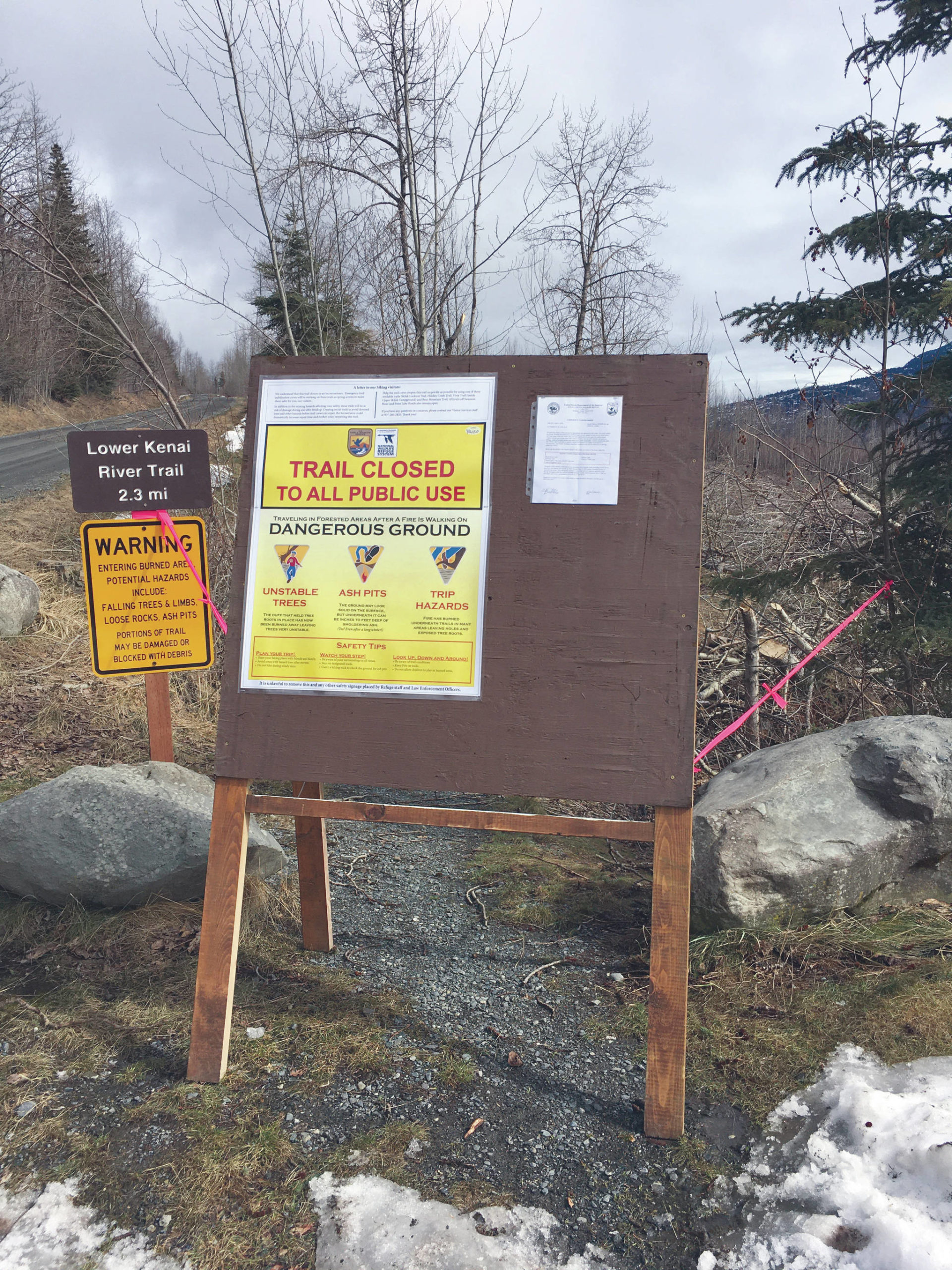Residents of the Kenai Peninsula are all too familiar with wildfire after the summer of 2019. Not only did the Swan Lake Fire burn for four months, but the Alaska Division of Forestry, Kenai Kodiak Area Office also responded to 71 other wildfires on the Kenai Peninsula and Kodiak Island.
What can we expect the following year after a significant wildfire such as Swan Lake?
Trees that grow here on the Kenai Peninsula are adapted to grow without a taproot. That means the root systems are very shallow and highly susceptible to falling after the organic material in which they are anchored has been burned. Even the slightest gust of wind can topple trees.
Over the course of last fall and this past winter, Kenai refuge employees and some firefighters from out of state focused on mitigating downed trees by removing them from roads, near utility infrastructure and trails. There’s much more work to be done, though.
As our long winter comes to a close, the frost comes out of the ground and will most certainly result in more downed trees on these travel corridors. Kenai refuge staff will largely be focused on keeping these corridors open for travel, but it is a tall order.
Ash pits are a real and dangerous hazard that existed last summer and will continue to pose a risk to any user within the Swan Lake Fire perimeter.
It is very likely that some of these ash pits have held hot embers through the winter and will continue to be hot through this spring and summer. Even without hot embers, ash pits are a tripping and footing hazard.
Ash pits are caused by a long-duration, smoldering combustion of organic fuels. They usually result in a hole of hot ash that can be up to 30 inches deep.
The temperatures are high enough in these ash pits to burn someone in a matter of seconds. There were several incidents of firefighters being burned in 2019 from ash pits, even with proper protective clothing.
So how can you stay safe this spring and summer, all while enjoying the Kenai National Wildlife Refuge?
Stay on hard-packed surfaces. The Kenai National Wildlife Refuge is in the process of clearing and re-clearing, assessing, and opening trails within the Skilak Wildlife Recreation Area. By staying on the trails (that are open), you will reduce the likelihood of encountering an ash pit.
Ash pits do, however, occur adjacent to the trails. By staying on designated trails and hard-packed surfaces, you also reduce the likelihood of encountering a fire-weakened tree because hazard tree mitigation measures have been taken on much of the trail system and the road system.
The Kenai Refuge website has the latest closure orders posted at https://www.fws.gov/refuge/kenai/.
Egumen and Marsh Lake trails are open to the public. Fuller Lakes trail is open up to Lower Fuller Lake. The trail from Lower Fuller Lake to Upper Fuller Lake remains closed.
Seven Lakes Trail is open from the Kelly Lake parking lot for the first half mile to access Kelly Lake Cabin. Seven Lakes Trail is also open from the Engineer Lake parking area to Engineer Lake Cabin. The trail in between both cabins and the spur from Hidden Lake are closed.
Kenai River, Hideout, Surprise Creek and Skyline trails are closed to the public. These trails sustained significant damage related to the fire and remain hazardous.
Keep pets on a leash. Pets as well as humans are susceptible to the dangers of ash pits. By keeping dogs and other pets on a leash, you can ensure that they too will stay out of the hazardous areas where ash pits may exist.
Smoke will likely be present in some areas of the Swan Lake Fire. Due to the 2019 drought conditions, the Swan Lake Fire burned for an exceptionally long time frame, with smoldering continuing after the flames were gone.
This caused the fire to burn into vegetation and organic soils deep underground. In a nondrought scenario, these fuels would likely be waterlogged or saturated. Due to the prolonged drought in 2019, these fuels were available for consumption.
Based on when these fuels were ignited, some may have smoldered throughout the winter and into this spring. Typically these smoldering fuels will produce a wispy, white drift smoke, coming from a source that may be hard to pinpoint.
It is best to stay out of areas with smoke. If smoke is present, it means that there is deep burning of the organic materials below the surface.
Stay vigilant this spring and summer as you recreate on the Kenai National Wildlife Refuge. Your safety is our No. 1 concern!
Michael Hill is the Assistant Fire Management Officer for Alaska Southern Refuges, stationed at Kenai National Wildlife Refuge. Find more Refuge Notebook articles (1999–present) at https://www.fws.gov/refuge/Kenai/community/refuge_notebook.html.
By MICHAEL HILL
Kenai National Wildlife Refuge


